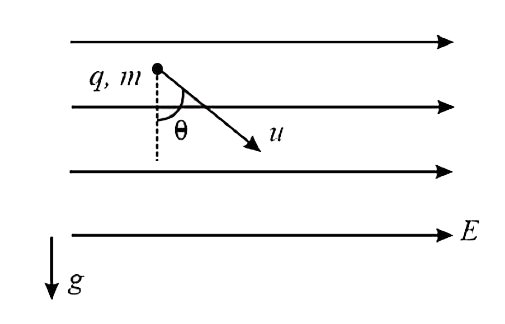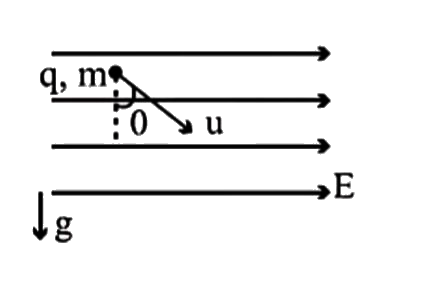A pariticle of mass m and charge q is thrown from a point in space where uniform gravitational field & electric field are present. The particle

1. may follow a straight line
2. may follow a circular path
3. may follow a parabolic path
1 &* 2 are correct
1 & 3 are correct
2 & 3 are correct
all these are correct
The correct Answer is:B
When force due to the gravitation field is equal to force due to the electric field, the particle must follow as straight line path with acceleration
When force due to gravitation field is not equal to force due to the elctric field the particle will follow the path of parabola, Hence 1 and 3 both are correct.
Topper's Solved these Questions
Similar Questions
A particle of mass m and charge q is thrown from a point in space where uniform gravitational field & electric field are present.The particle

(1) may follow a straight line
( 2) may follow a circular path
( 3) may follow a parabolic apth
View SolutionA particle of mass m and charge q is thrown from a point in space where uniform gravitational field & electric field are present.The particle

(1) may follow a straight line
( 2) may follow a circular path
( 3) may follow a parabolic apth
View Solution
Knowledge Check
A particle of mass m and charge q is thrown in a region where uniform gravitational field and electric field are present. The path of particle:
Astraight lineBellipseCparabolaDcircleA particel of mass m and charfe q is throun in a region wihere unirfrom gravittional field and electric field are present . The path of particle -
Astraight lineBellipseCparabolaDcircleA particle of mass m and charge q is thrown in the vertical direction with a velocity v0 in a uniform horizontal electric field E. Assuming the gravity force to be negligible ,the equation of the path followed by the particle will be
Aparabola ,x=(qE2mv20)y2Bhyperbola , x=qE2mv20yCstraight line ,x=qEy2mv20Dnone of the above
A particle of mass m and charge q is thrown in a region where uniform gravitational field and electric field are present. The path of particle:
View SolutionThe work done in moving a charge particle between two points in a uniform electric field, does not depend on the path followed by the particle . Why ?
View SolutionA charge particle travels along a straight line with a speed v in region where both electric field E and magnetic field b are present.It follows that
View SolutionA particle of mass m and charge q enters a magnetic field B perpendicularly with a velocity v, The radius of the circular path described by it will be
View SolutionA charge particle travels along a straight line with a speed v in region where both electric field E and magnetic field b are present.It follows that
View Solution
